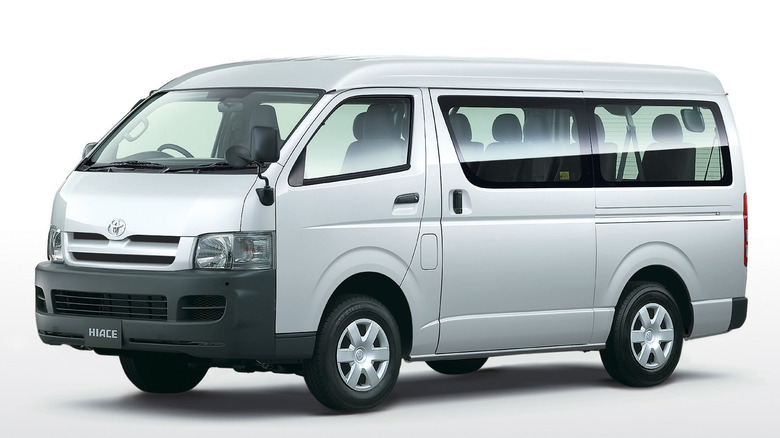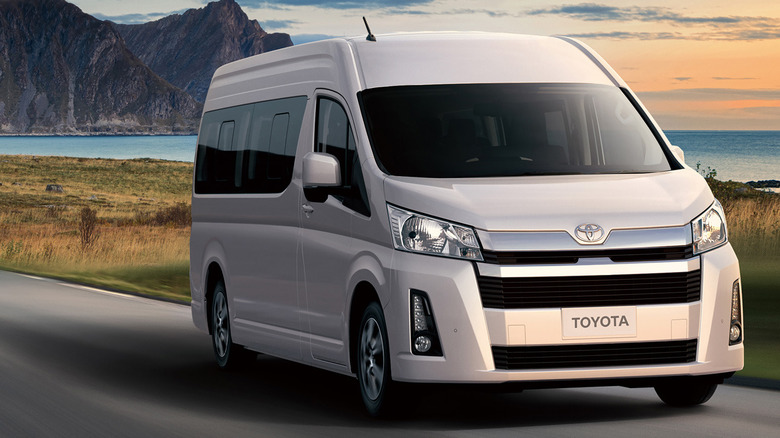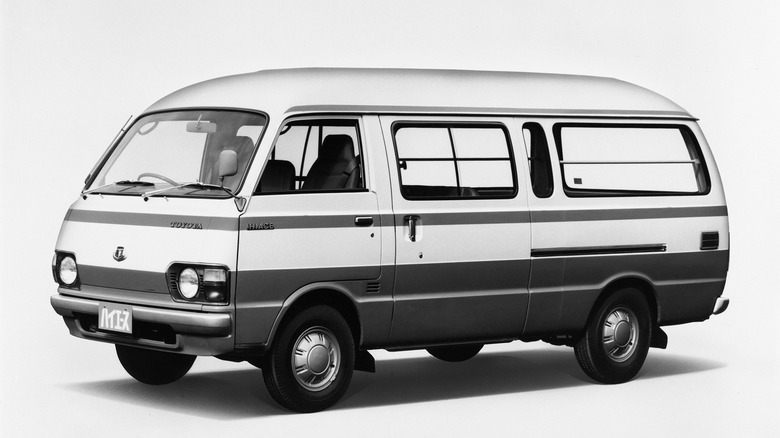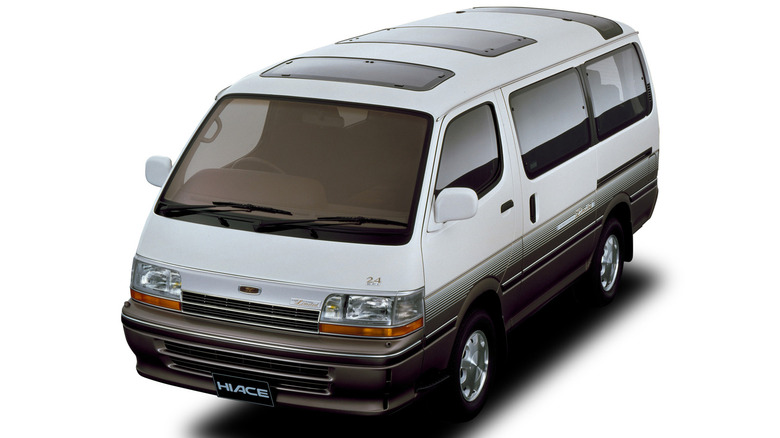Here's Why You Can't Buy Toyota's HiAce Van In The US
The Toyota HiAce van is one of the most immediately recognizable Toyotas, but not for North American drivers. By Toyota's count in 2019, the van has sold over 6.2 million units over six generations since 1967. With other Toyota vans like the Sienna remaining consistently popular in the States over a couple of decades, why didn't Toyota ever send the HiAce over to the United States? Before tackling that mystery, it's important to assess the intended market of the HiAce and what it's used for.
The Toyota HiAce occupies a segment that doesn't really exist in the United States if you took a serious survey of the vehicles typically offered in North America (and to a lesser extent Europe). It's a do-anything vehicle in that, while it's classified as a commercial vehicle, it can act as a high-class luxury bus, a ferry for kids to and from school, a purpose built utility truck, or just a regular contractor's van. The HiAce can be thought of as a flexible platform, rather than a specific body style targeting a specific segment of the automotive market.
The HiAce is a global vehicle
Toyota's HiAce is decidedly a vehicle for the global market, and not really any specific locale. In a press release announcing changes for the sixth generation HiAce specific for the Philippines, Toyota says: "Following launch in the Philippines, the new model is to be gradually introduced in other countries and regions, with a focus on emerging markets." Additionally, Toyota says that, "In emerging markets, where the automobile market has continued to expand ... demand has risen for passenger transportation including tourist minibuses, private buses, and vehicles for use in logistics. The new HiAce has been developed to be able to flexibly respond to these diverse needs."
Reading between the lines a bit, you can glean that Toyota has the rest of the world — more specifically emerging markets like South East Asia and Africa — in mind. While one may think that Toyota had a more sinister motive for depriving the North American market of a cool and nearly infinitely configurable van, the simple truth is that it wasn't made with that market in mind.
Shifting trends kept the HiAce out of America
Going back into Toyota's history a bit, Toyota fans might remember that a distant smaller cousin of the HiAce did see a brief life in the States. It was sold under the plain, yet descriptive name of the "Toyota Van" from 1984 to 1989. The rest of the world would know it as the "LiteAce" or "TownAce." The Toyota Van would pave the way for other stateside Toyota vans like the lovably weird Previa, and smash-hit Sienna. As market tastes evolved over the years, minivans — once the monsters of the family car segment — gradually started to play second fiddle to SUVs and crossovers. The same market trend spelled the death of the sedan among American brands.
Even if the larger HiAce did get shipped overseas to the U.S. market, its days as a passenger focused vehicle would have been numbered from the start as the market shifted. As a commercial vehicle, the picture would have been even more grim. As it stands, only the Big Three — Ford, General Motors, and Stellantis/Chrysler (with the exception of the Mercedes-Benz Sprinter) — have forever been successful and high-selling commercial vans in the United States.
Decades ago, Toyota more than likely knew it didn't want to spend the time and pay the import taxes on a commercial van that probably wouldn't sell very well in the first place. The automaker did the math and decided that other global markets were better suited for the HiAce and its derivatives instead.
The import market is booming
Despite the fact that the United States never got to see a new HiAce as it was originally sold, that doesn't mean it's entirely absent. The imported cars market has exploded in popularity as more formerly off-limits cars reach the prerequisite vintage to be sent overseas, and the HiAce is no exception. Car enthusiast auction sites like Cars and Bids is full of Toyota HiAce vans in a number of configurations ranging from a fire truck to a camper, many of which have sold.
Prices are even fairly reasonable for mid-1990s examples, ranging from around $7,000 to $16,000. Since many of these vans have already been imported, you don't have to go through the trouble of having to get it shipped thousands of miles on a container ship, or deal with any requisite Customs issues and obeying U.S. automotive regulations.
All told, shifting market trends in the United States were the most likely culprit for why Toyota never tried to offer it officially. It's very likely the Japanese automaker didn't see it as a profitable venture. However, don't let that stop you from getting your hands on a classic HiAce if you want to see what the rest of the world is driving.



